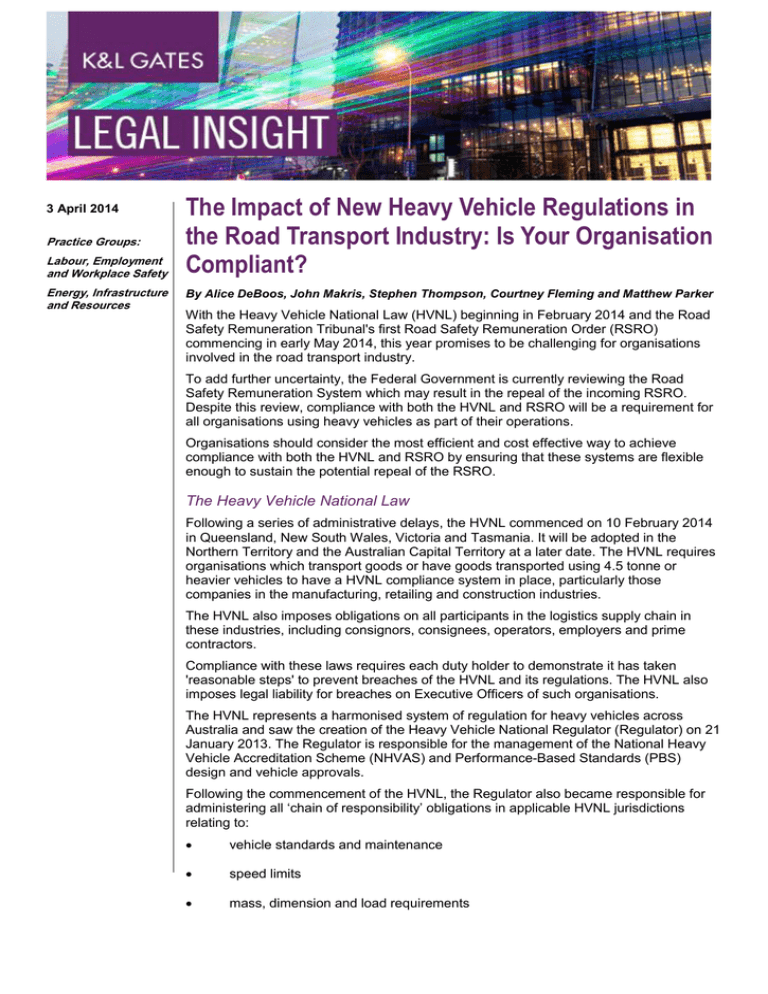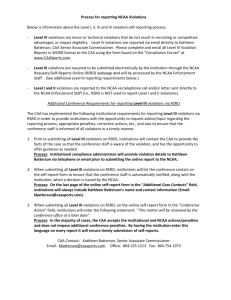
3 April 2014
Practice Groups:
Labour, Employment
and Workplace Safety
Energy, Infrastructure
and Resources
The Impact of New Heavy Vehicle Regulations in
the Road Transport Industry: Is Your Organisation
Compliant?
By Alice DeBoos, John Makris, Stephen Thompson, Courtney Fleming and Matthew Parker
With the Heavy Vehicle National Law (HVNL) beginning in February 2014 and the Road
Safety Remuneration Tribunal's first Road Safety Remuneration Order (RSRO)
commencing in early May 2014, this year promises to be challenging for organisations
involved in the road transport industry.
To add further uncertainty, the Federal Government is currently reviewing the Road
Safety Remuneration System which may result in the repeal of the incoming RSRO.
Despite this review, compliance with both the HVNL and RSRO will be a requirement for
all organisations using heavy vehicles as part of their operations.
Organisations should consider the most efficient and cost effective way to achieve
compliance with both the HVNL and RSRO by ensuring that these systems are flexible
enough to sustain the potential repeal of the RSRO.
The Heavy Vehicle National Law
Following a series of administrative delays, the HVNL commenced on 10 February 2014
in Queensland, New South Wales, Victoria and Tasmania. It will be adopted in the
Northern Territory and the Australian Capital Territory at a later date. The HVNL requires
organisations which transport goods or have goods transported using 4.5 tonne or
heavier vehicles to have a HVNL compliance system in place, particularly those
companies in the manufacturing, retailing and construction industries.
The HVNL also imposes obligations on all participants in the logistics supply chain in
these industries, including consignors, consignees, operators, employers and prime
contractors.
Compliance with these laws requires each duty holder to demonstrate it has taken
'reasonable steps' to prevent breaches of the HVNL and its regulations. The HVNL also
imposes legal liability for breaches on Executive Officers of such organisations.
The HVNL represents a harmonised system of regulation for heavy vehicles across
Australia and saw the creation of the Heavy Vehicle National Regulator (Regulator) on 21
January 2013. The Regulator is responsible for the management of the National Heavy
Vehicle Accreditation Scheme (NHVAS) and Performance-Based Standards (PBS)
design and vehicle approvals.
Following the commencement of the HVNL, the Regulator also became responsible for
administering all ‘chain of responsibility’ obligations in applicable HVNL jurisdictions
relating to:
vehicle standards and maintenance
speed limits
mass, dimension and load requirements
The Impact of New Heavy Vehicle Regulations in the Road Transport
Industry: Is Your Organisation Compliant?
fatigue management requirements.
The National Transport Commission (NTC) recently issued a review paper (Paper) titled
Chain of Responsibility Review Assessment of Options Paper February 2014. This is part
of the ongoing review of the chain of responsibility provisions in the HVNL. The public
comment period for submissions closed on 14 March 2014.
The Paper sets out a number of options for the adoption of components of the model
Work Health and Safety (WHS) legislation. These include:
adoption of the standard of 'reasonably practicable'
broadening the definition of 'responsible parties'
an increase in enforcement measures, such as prohibition notices
increases in penalty levels consistent with those in the WHS legislation.
It remains to be seen whether all or some of these options are adopted and the
implications for those that form part of the chain of responsibility.
Road Safety Remuneration Order
Following an extensive consultation and submission process, the Road Safety
Remuneration Tribunal made its first RSRO on 17 December 2013. The RSRO will run
for a period of four years from 1 May 2014 and will impose numerous obligations on
participants in the supermarket retail and long distance supply chains.
The RSRO requires:
contractor drivers to be paid for their services within 30 days of a hirer's receipt of
a valid received invoice
road transport drivers to have written contracts, with these contracts to be made
available in electronic format
contracts between supply chain participants to be compliant with the RSRO
safe driving plans to be prepared for long distance operations in a heavy vehicle
(any vehicle weighing over 4.5 tonnes)
training in work health and safety to be provided to road transport drivers
employers and hirers to implement RSRO compliant drug and alcohol policies
compliance with the RSRO's dispute resolution procedure
road transport drivers to be protected from adverse conduct in specific
circumstances.
The issue of rates of payment for road transport drivers is the subject of additional
proceedings in the Road Safety Remuneration Tribunal, with these proceedings also
investigating forms of payment and what constitutes 'work' for the purposes of receiving
payment.
2
The Impact of New Heavy Vehicle Regulations in the Road Transport
Industry: Is Your Organisation Compliant?
The Pending Review
The RSRO has been criticised by various stakeholders within the road transport industry
due to its perceived overlap with the HVNL, work health and safety laws and the
regulatory burden it will place on the industry. As a result of these perceived issues, the
Federal Government announced late last year that it would conduct a review of the Road
Safety Remuneration System. The review is designed to assess the operation of the
Road Safety Remuneration Act 2012 (Cth) and the Road Safety Remuneration Tribunal
and provide advice on whether the system effectively addresses safety concerns in the
road transport industry.
The future of the Road Safety Remuneration System will likely depend on the outcome of
this review and the composition of the Federal Senate following 1 July 2014.
What Does This Mean for Your Organisation?
The obligations imposed under the HVNL and RSRO are onerous and the full impact of
these changes are currently unclear.
While all affected organisations should have in place HVNL compliant systems, the
potential repeal of the RSRO means that a substantial question remains: does your
organisation also need to ensure compliance with the RSRO even if it may be repealed?
The simple answer is 'yes'.
Compliance with the RSRO is mandatory and all organisations involved with the road
transport industry should ensure that steps are taken to satisfy its obligations under both
the HVNL and RSRO by ensuring that:
directors and senior managers are made aware of the Executive Officer liability
provisions within the HVNL
all relevant employees (including road transport drivers) are aware of the steps
that must be taken to achieve compliance with both the HVNL and RSRO
contractual arrangements, safety and operating systems, training programs and
internal policies (eg drug and alcohol policies, safe driving plans and driver
contracts) are updated to reflect the obligations imposed by the RSRO.
While the RSRO arguably represents a 'best practice' approach to management of road
transport drivers, it does impose quite onerous and potentially costly obligations on
organisations that are involved with the road transport industry.
Given the impending Federal Government review and uncertainty surrounding the future
of the RSRO, organisations may wish to proceed with some caution when taking steps to
overhaul their systems and practices to allow for some flexibility should the RSRO be
later repealed. When reviewing current systems and procedures organisations may wish
to:
ensure that any long term contracts address the possibility that the RSRO will be
repealed and provide scope for the organisation to vary contractual relationships
in consequence of an anticipated regulatory change
give consideration to whether the organisation's current systems and procedures
may be later amended to be solely HVNL compliant if required.
3
The Impact of New Heavy Vehicle Regulations in the Road Transport
Industry: Is Your Organisation Compliant?
Authors:
Alice DeBoos
alice.deboos@klgates.com
+61.2.9513.2464
John Makris
john.makris@klgates.com
+61.2.9513.2564
Stephen Thompson
stephen.thompson@klgates.com
+61.2.9513.2369
Courtney Fleming
courtney.fleming@klgates.com
+61.2.9513.2553
Matthew Parker
matthew.parker@klgates.com
+61.2.9513.2491
Anchorage Austin Beijing Berlin Boston Brisbane Brussels Charleston Charlotte Chicago Dallas Doha Dubai Fort Worth Frankfurt
Harrisburg Hong Kong Houston London Los Angeles Melbourne Miami Milan Moscow Newark New York Orange County Palo Alto
Paris Perth Pittsburgh Portland Raleigh Research Triangle Park San Diego San Francisco São Paulo Seattle Seoul Shanghai
Singapore Spokane Sydney Taipei Tokyo Warsaw Washington, D.C. Wilmington
K&L Gates practices out of 48 fully integrated offices located in the United States, Asia, Australia, Europe, the Middle East and
South America and represents leading global corporations, growth and middle-market companies, capital markets participants and
entrepreneurs in every major industry group as well as public sector entities, educational institutions, philanthropic organizations
and individuals. For more information about K&L Gates or its locations, practices and registrations, visit www.klgates.com.
This publication is for informational purposes and does not contain or convey legal advice. The information herein should not be used or relied upon
in regard to any particular facts or circumstances without first consulting a lawyer.
©2014 K&L Gates LLP. All Rights Reserved.
4







